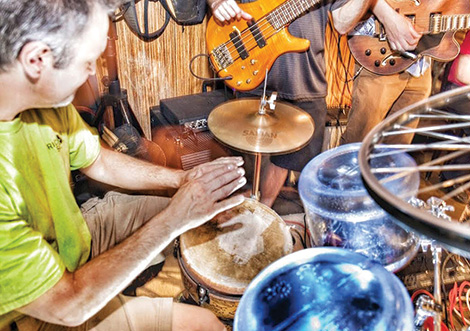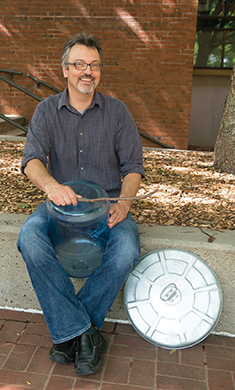KEEP THE PERFECT BEAT

With Steven McAlpine, assistant director of interdisciplinary studies and percussionist with Straight Up Tribal
Back in 2008, Steven McAlpine decided that UMBC needed a beat. Right at the heart of the campus.
So the director of UMBC’s interdisciplinary studies program sat with his djembe (an African drum) on the UMBC Quad and started to play. He didn’t expect anyone to join in. But his beat proved irresistible and the weekly drum circle that formed around McAlpine quickly grew past double digits. On some Fridays, the gathering of rappers, hoop dancers and other percussionists gets as high as 20 performers.
“We just showed up and didn’t ask permission,” McAlpine says. “But maybe we should have. Some people would stop and listen. Some people would leave quarters in our hats. The best part would be people saying, ‘If I bring a drum next week, can I join in?’”
A more formal ensemble, Straight Up Tribal, has also emerged from the drum circle. McAlpine has fashioned his own drum kit for that group, consisting of an orange Home Depot bucket (bass), two water coolers (toms), and his wife’s bike tire rim (high hat).
“Building your own instrument affects your perception of beat,” he observes.
So whether it’s on a high hat or a hat box, how do you keep the perfect beat?
Tools of the Trade
1. Orange Home Depot bucket
2. Two water coolers
3. Bike tire rim
4. Spirit of adventure
5. A pair of ears to listen
Step 1: DON’T BE OPPRESSED BY PERFECTIONISM
Before starting the Quad drum circle, McAlpine says he was a slave to the metronome and craved precision and planning. He used influences to guide his style rather than allowing himself to play freely.
Since beginning the drum circle and finding the dynamism in playing with a group, he says he has made a much needed shift from “mathematical to soulful.”
One key to keeping a great beat is overcoming the idea that there is only one way to play a song. Depending on what McAlpine plays – the djembe, a traditional kit, or his buckets – the sound comes to him and emerges differently.
The challenge, he says, is to “keep it fresh, but really hone your skill.”

Step 2: FIND THE PULSE IN EVERYTHING
Just as painters find inspiration in the world around them, McAlpine hears a beat in his footsteps or in the ring of someone’s cell phone.
“Beat is in everything,” he says. “We just shape it. In the noise, I hear a pattern, and think, ‘I wonder what that sounds like on the drum.’”
Hear it, feel it, and then make it, McAlpine says.
Step 3: CREATE SPACE
Once you establish a beat, you might think that there’d be no more room for another rhythm or percussive element. But if all the space in a performance is taken up by one driving force, it leaves no room for collaboration.
McAlpine says keeping a great beat is about “filling the spaces, then leaving spaces. Beat is both a prompt as well as a constraint that sets us free.” When collaborating with others, he says, “It’s about an invitation for other people to join in.”

Step 4: WATCH THE AUDIENCE
Any perceptive percussionist is also tuned into the audience. If people start to sway, beat on the table or tap their feet, he knows it’s affecting them. “Does it make you want to dance? To me, that’s the test. It’s about connection.”
McAlpine prefers playing with a large band because of the dynamism that comes with doing so, and the same goes for playing in front of (and sometimes with) an audience.
“If no one’s watching,” he says, “then what’s the point?”
Step 5: GET AMBITIOUS
Even a seasoned percussionist like McAlpine says that there are challenges in collaboration. A singer may start a song with a rhythm that’s not as intuitive as most, so McAlpine waits. And he listens. And then he finds his opportunity and dives in.
“The right way is to play together, to find some common ground,” he says. “We are pattern-making and pattern-detecting people, and the pulse is what allows for creative collaboration.”
— Sarah C. Truckey

By The Numbers
These are the three most influential songs that inspired me as a drummer – delicious puzzles for me that inspired hours of practice and song analysis in the hopes of “mastering” the drum set. I am still working on the mastery part.
1. The Edgar Winter Group, “Frankenstein” (the first drum solo I ever learned note for note, from the album They Only Come Out at Night).
2. Led Zeppelin, “Good Times Bad Times” (from Led Zeppelin I)
3. Rush, “Tom Sawyer” ( from the album Moving Pictures. This song inspired me to use a double bass drum pedal).
— Steven McAlpine
Tags: Summer 2014

